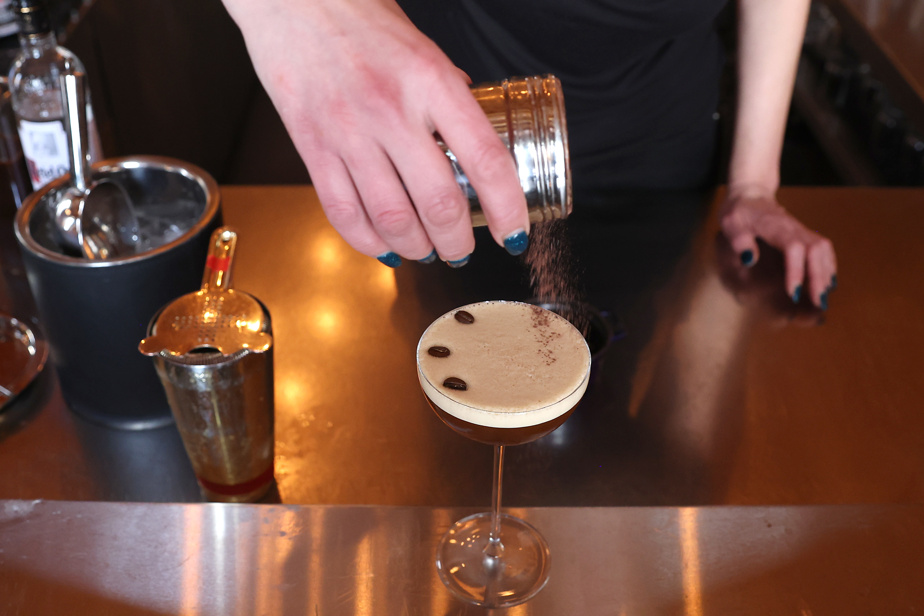Passed into oblivion during the resurgence of cocktails in the early 2000s, the espresso martini is now the darling of distillers, mixologists and it is even a star of the social network TikTok. This mixture of coffee and vodka is easy to make, chic and, above all, it wakes up!
Everyone in the bar industry knows the story of the creation of the espresso martini. Modern, compared to the dry martini or the negroni, it was invented by the Englishman Dick Bradsell in the 1980s.
“A supermodel would have asked her for a drink to wake her up and keep her awake all night,” says consultant mixologist Pierre-Hugues Marois.
Dick Bradsell came up with the idea of using coffee to wake up his client. Then he combined an espresso, sugar, vodka and ice in his shaker, before shaking it vigorously. A thick foam then formed on the drink, which is reminiscent of the cream that forms on coffee.
Served in a cup, this creation is now famous. But Dick Bradsell did not have the chance to measure the extent of it. He died in 2016 just before his cocktail party had its true heyday.

PHOTO ROBERT SKINNER, THE PRESS
The espresso martini was born from the imagination of bartender Richard Arthur Bradsell in the 1980s.
Incredible popularity
At boutique hotel Mount Stephen in Old Montreal, George bar manager Nader Chabaane is unequivocal: the espresso martini is the best-selling cocktail over the past year. His establishment prepared nearly 16,000 of them!
At the Société des alcools du Québec (SAQ), the St-Laurent distillery and mixologist Rose Simard recently marketed three canned cocktails under the Liquid Love brand. The espresso martini is by far the most popular of the three, says the project’s marketing manager, Catherine D’avril.
Consultant Pierre-Hugues Marois attributes the popularity of this cocktail to the simplicity of the ingredients: coffee and vodka.
People understand what it will taste like. It contains no obscure or technical ingredients that are only in vogue among mixologists. During the pandemic, anyone could make it at home. But there, everyone orders. It’s excessive.
Pierre-Hugues Marois
With such demand, it is impossible for George Bar Manager Nader Chabaane to brew fresh coffee with every order. Like many other mixologists, he brews liters of coffee or uses a cold brew coffee concentrate, a ColdBrew. This way it cuts the working time in half without compromising the taste.
“It takes four minutes to prepare the cocktail with a fresh espresso,” he observes. When you do 100 in one evening, it’s too long! »

PHOTO ROBERT SKINNER, THE PRESS
Preparing an espresso martini at Bar George
At Café Pista in Montreal, barista Maxime Richard created cold brew coffee during the pandemic. Its preparation was quickly adopted to make the espresso martini.
His company also collaborates with several distilleries, including BluePearl, in the production of a coffee liqueur. Because this drink is found today in the majority of espresso martini recipes. More than six different Quebec coffee liqueurs have arrived on SAQ shelves in recent months.
“Choosing grains to design a liqueur is no small task”, admits Maxime Richard. The production of alcohol containing a stimulant, such as coffee, is regulated. It is therefore necessary to find a decaffeinated product full of flavors.
Decaf has been demonized, for good reason. Historically, these were poor quality coffees, but we are very proud of the ones we use.
Max Richard
If the alcoholic liquor cannot contain a large amount of caffeine, there is nothing regulating the creation of the espresso martini. All types of coffee are allowed. However, the barista recommends favoring grains that are neither too dark nor too full-bodied with sweet notes of chocolate, caramel and hazelnut.
The best
At the St-Laurent distillery, Catherine D’avril observes that a comment keeps coming up about her espresso martini in a can: the foam is missing.
This is formed using freshly brewed coffee. To achieve this, it is not uncommon for bars to add a few drops of emulsifier.
“The foam is the key element of the cocktail, adds Pierre-Hugues Marois. It’s stylish. You can decorate it with coffee beans. »
On the social network TikTok, the cocktail comes in thousands of ways. In addition to the essential coffee beans, there are variations inspired by the tiramisu dessert decorated with cocoa powder, others are accompanied by biscuit, marshmallow and even parmesan.

IMAGE FROM A VIDEO
An espresso martini… and marshmallow
In the middle of the wood-paneled room at Bar George, Nader Chabaane will soon have the luxury of thinking about decorating his espresso martini. The establishment has acquired a brand new device, the DrinkBrood. The Canadian-designed device uses nitrogen to make a variety of beverages. Just place the cup and pull the crank, like a beer on tap, to serve an espresso martini worthy of the great tables.
“It’s even better than when it’s shaken and it takes 20 seconds,” he says.
Like Catherine D’avril, the mixologist believes that demand for this cocktail is far from dying down.
Recipe for the espresso martini, by Pierre-Hugues Marois

PHOTO ROBERT SKINNER, THE PRESS
Espresso martini at Bar George in the Mount Stephen Club.
Ingredients
- 2 oz of espresso, the equivalent of a double
- 1.5 oz vodka
- 0.5 oz coffee liqueur
- 0.25 oz simple syrup
Method

PHOTO ROBERT SKINNER, THE PRESS
Espresso martini at Bar George in the Mount Stephen Club.
- Prepare the simple syrup by dissolving one part sugar in one part water on the stove. Once cooled, the syrup is ready.
- Combine all ingredients in a shaker filled with ice. Shake vigorously. Double strain through a fine strainer.
- Serve in a cup. Garnish with a coffee bean.
- Pro tip, add a few grains of salt to enhance the taste.
For a non-alcoholic version, Pierre-Hugues Marois suggests swapping the same quantity of vodka for the non-alcoholic gin Seedlip Spice 94.
